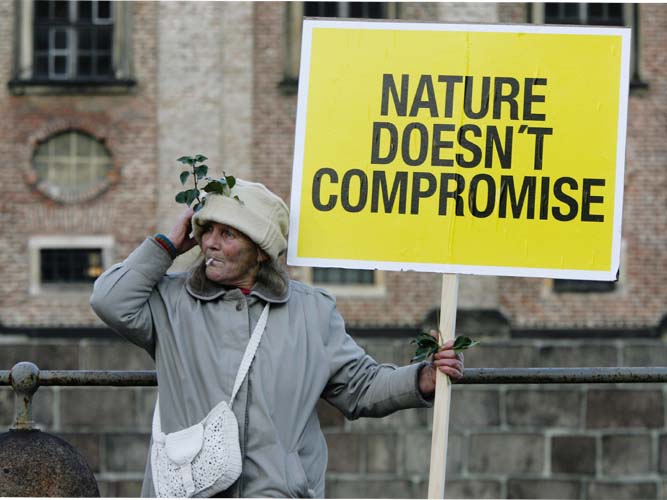
Copenhagen Hangs by Two Threads
With less than 48 hours remaining to thrash out something concrete that a hundred and twenty heads of state presently arriving can sign, Copenhagen is pushing its luck. Forbes India gets you all the details from ground zero
To KP or not to KP, that is the question (having come all the way to Denmark, it’s only fitting to borrow from Hamlet)
As 193 countries, Somalia being the latest entrant, work to hammer out a “fair and ambitious” climate deal in Copenhagen, the crux of the contention is whether the new regime to reduce green house gas emissions should be a spanking new deal-labeled Long term Cooperative Action (LCA) or an extension of the Kyoto Protocol (KP).Todd Stern, US special envoy for climate change has called this the most contentious issue in the entire negotiation process in Copenhagen. All working group meetings were temporarily suspended on the first day of the second week of the Conference, initiated by a walkout by the African countries and the rest of G77.
The LCA draft proposal encompasses new targets from developed nations, verifiable actions from major emerging economies such as India and China, and of course the inclusion of the major emitter US in the treaty. The KP draft on the other hand looks at the second commitment period for emission reductions of Annex 1 countries, with fines and for all the nations who do not comply in the current period (which is currently everyone except UK, Germany & France). The KP also does not impose any binding targets on the developing nations. Is it any wonder that while the G77 is keen to go the Kyoto way, many developed countries are focusing their energies on the LCA draft.
The European Union on Tuesday held a conference, defending their validation of the LCA draft. European Union's environment commissioner Stavros Dimas stressed he was backing an agreement that’s “more ambitious than Kyoto” which proposes higher targets and offers a mechanism to finance developing nations.
There is also a lot of uncertainty regarding the final shape of the agreement. With just four days to go before a new deal is struck, the EU in a conference on Tuesday said it was unwilling to raise its emissions reduction target from 20 to 30 percent over 1990 levels by 2020, unless it saw progress in terms of actions by the biggest emitters namely India and China. Meanwhile the BASIC countries — Brazil, South Africa, India and China having announced proposed cuts in their carbon intensity levels were unwilling to make them legally binding or put them under any international scrutiny (monitoring, reporting and verification of target reductions) unless they are supported financially and technologically.
The US meanwhile is sticking to its stand that it will not sign a Kyoto under another name and Africa says it’s unwilling to sign anything that excludes it.
The United Nations Framework Convention on Climate Change (UNFCCC) insists that the conference so far has not been without some progress. Take short-term financial commitments to developing countries to adapt and mitigate climate change. The EU has offered 3.6 billion dollars a year over 3 years, Japan is expected to pledge 10 billion dollars over the same period, and Mexico and Norway have put forward a joint funding model for developed countries totaling around 30 billion dollars.
On the sidelines, the US and Australia with a handful of European countries also proposed to channel 350 million dollars for five years though the World Bank for transfer of low carbon energy technology and implementation of energy efficiency standards under a plan called Climate REDI. India was a signatory to this.
But is the cumulative money on the table enough? What is the overarching structure to generate, transfer and monitor it? How much of it will be re-hashing of existing development funds? How much of it will be market driven, and what about finance in the long-term? There is nothing concrete on the negotiating table on these fronts.
Yvo de Boer, the executive secretary of the United Nations Framework Convention on Climate Change (UNFCCC), when asked on Monday how the conference was progressing said, if you talk about where we are on the mountain, we are on a cable car and the rest of the ride is going to be, “fast, smooth and relaxing.”
Ironically, things have been falling apart ever since. Peaceful protests outside allegedly turned violent followed by mass arrests. Tear gas was used to dispel a crowd outside the conference center according to eyewitnesses on Tuesday. Organisationally thousands of the 45,000 plus registered delegates have been left queuing in cold outside the conference center meant to hold just 15,000 people, (temperatures fell below zero today). Tensions are running high as many of the press and almost all of the observers are being kept out of plenary sessions and forthcoming high-level meetings. And that’s just the logistics.
As I write this, the ad-hoc working group drafting the Kyoto protocol text has just ended. The chair of the group needs to now submit this draft to the high level ministerial meeting on Wednesday. But India, China, Algeria, Saudi Arabia and Sweden all ended the meeting, voicing the same concern. The work of the Kyoto track has fallen behind and there are still many ambiguities and reservations. One of the Indian delegates remarked to the chair, “We have nothing to report, what can we give to COP-MOP?”
With less than 48 hours to go to thrash out something concrete that a hundred and twenty heads of state presently arriving can sign, the drafts will now be bumped up to the respective environment ministers to resolve. The question is can they make the square brackets enveloping the objections, contentions and alternative options of every country and negotiating bloc miraculously disappear?
(The author is a Deputy Special Features Editor at CNN-IBN and is currently on a sabbatical at Oxford University)
Post Your Comment















